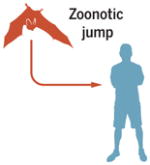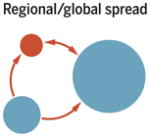On 14 January 2016, Liberia was declared Ebola-free. A new case was identified shortly after the announcement, but it is nevertheless clear that the West African epidemic has moved on to a more hopeful phase. What lessons can be drawn from the Ebola crisis to help the international community to prepare for and respond to the next global epidemic? This question is particularly pertinent given the recent declaration of the Zika virus as a public health emergency.
RESPECTFUL LOCAL HEALTH CARE
Over US$7 billion were raised for the Ebola response, and international efforts were made to supply personnel. But it was ultimately underequipped local workers on the ground who bore the brunt of the epidemic: More than 800 health care workers were infected, and more than 500 died. These facts underscore the importance of rebuilding and strengthening local health care and health surveillance networks, as well as building trust in both the health care system and political structures.
In public remarks on the epidemic, Margaret Chan, the Director-General of the World Health Organization (WHO), stated that “when communities saw for themselves that hiding patients in homes could lead to the death of entire households, they found their own way to separate the healthy from the infected… These changes in community behaviours helped bring some of the earliest hotspots under control” (1). In fact, treating the rights of the infected and their families as secondary to the urgent need for infection control proved counterproductive: It undermined containment of the epidemic and led to the loss of more lives. Former Irish President Mary Robinson has argued that safeguarding the human rights of victims is essential to effective control of an epidemic (2).
INTERNATIONAL RESPONSE
At the same time, a more efficacious, timely international response is essential. The first Ebola cases were confirmed in March 2014; just 2 months later, Médecins San Frontières declared the epidemic to be out of control. Yet, the WHO did not convene an international meeting on the outbreak and declare it a Public Health Emergency of International Concern (PHEIC) until August 2014. As the international body charged with responding to infectious disease outbreaks, the WHO must have the mandate, authority, and capacity to respond faster and with much greater impact.
The need for reforms at the WHO has been stressed from several expert panels (3–6). All these panels have recommended the setting up of a dedicated Center for Health Emergency Preparedness and Response within the WHO, with an independent advisory group, transparent decision-making, and a protected budget that cannot be cannibalized for other issues. The WHO must also implement its existing mandate to require and assist countries to define and develop minimum core capacities for detecting and reporting outbreaks. The United Nations should oversee the progress of these initiatives and offer assistance, especially in fragile and failed states. Finally, research must be sustained and coordinated both between and during epidemics. The National Academy of Medicine frames these issues as matters of global security and estimates implementation costs of $4.5 billion per year (5).
MULTIPLE PERSPECTIVES
Although the expert panels discussed above emphasize the need for coordinated research, their focus is mainly on biomedical disciplines. A more successful approach to future outbreaks needs to coordinate knowledge from many disciplines in two main ways. First, scientists must quantify and ideally predict the course of an epidemic from its zoonotic origins in reservoir species, through the course of the epidemic, to its wider effects on health systems and society. Second, every aspect of this research program needs to move beyond customary disciplinary silos, integrating insights from the natural sciences, public health, and clinical medicine with those from engineering, social science, and ethics.
Three examples underline the multidisciplinary nature of the research challenge (see the table). First, the risk of zoonotic emergence must be mapped using innovative surveillance methods, data that track human movement, and computational methods (7). However, the risk of human contact and the emergence of disease also depend on economic and social factors such as travel, migration, and urbanization (8).
Table.
Research needs for different stages of emerging zoonotic infections
| Stage of the epidemic |

|

|

|
| Research priorities | Reservoir and pathogen transmission rates and dynamics; pathogen surveillance and novel host serology; pathways for contact with humans. | Public health, syndromic and pathogen genetic surveillance; development of rapid diagnostics and informatics; estimation of transmission rates and construction of epidemiological models; quantifying pathogen evolution; vaccine and drug treatment development; testing, logistics, and sensitive deployment of control strategies; behavior change. | Mapping spread through quantifying human mobility; broader deployment of control measures; mobilizing political and economic will to prevent spread and aid victims. |
| Fields of research needed | Veterinary science, ecology, evolutionary biology, microbiology, immunology, anthropology, sociology, geography, and economics. | Biomedicine, pharmacology, epidemiology, pathogen evolutionary biology, biostatistics, engineering and supply chain logistics, economics, sociology, anthropology, ethics, politics, and communications. | Geography and informatics, epidemiology, politics, economics, ethics and law. |
Second, integrating data from genetic analysis of pathogens and medical surveillance into epidemiological models is a key step in understanding epidemic spread and the effects of control efforts. Understanding implications from molecular virology and immunology for the dynamics of population herd immunity is a crucial area for research. However, the Ebola epidemic has shown that social structures, living environments, and human behavior all shape the course of an epidemic (9). Understanding behavior change (and especially culturally appropriate ways to influence it) requires expertise from fields such as anthropology and psychology; without such insights, control measures can founder.
Third, safe, efficient, and deployable vaccines and treatments, along with close-to-patient diagnostics, could mitigate future outbreaks and protect frontline health workers. The recent successful and remarkably rapid trial of a safe and effective Ebola vaccine in Guinea is a triumph (10), but there is no technical reason why it (and alternative Ebola vaccines) could not have been available for deployment several years ago. The main impediment has been the lack of a reliable market for a vaccine. The 20 January agreement by the Global Alliance for Vaccines and Immunizations (GAVI) to purchase the Merck vaccine when it becomes available illustrates what can be done.
Developing an international cooperative mechanism to support the development and licensing of vaccines is an urgent priority (11). We hope that the Ebola crisis will provide the impetus to finally get this effort off the ground, particularly because new threats, such as the Zika virus, continue to emerge. The Zika virus epidemic also underlines the importance of research and development in the control of vector-borne diseases.
ACTING SYNERGISTICALLY
Past epidemics show that international aid can be highly successful (12). HIV-AIDS has become a chronic rather than fatal condition, even in many low-income countries, because of access to life-saving drugs; childhood deaths due to malaria have been massively reduced in the past 15 years (13); and access to vaccines has been much improved, all as a result of coordinated national and international efforts. This history shows that the best results are achieved when international mechanisms act synergistically with strong local governance and health systems and with a shared agenda.
The difficulty in extinguishing Ebola in Liberia and Sierra Leone highlights the very real challenge of eradicating human infection from a country after it has become well established. Because of the possibility of long-term human carriage of Ebola, low-level sexual transmission, and relapse, the road to zero cases still requires massive effort and commitment. Death and disease stemming from an outbreak are likely to linger long after the last country is declared Ebola-free. In the aftermath of the Ebola epidemic, strains on already fragile health systems can exacerbate other infectious disease outbreaks (14).
Trauma, stigmatization, hunger, and poverty stemming from the outbreak are also likely to have long-term consequences on survivors, their families, and communities. The effects may be particularly severe for the youngest children affected. Documented effects of exposure to other infectious diseases in utero and early childhood include stunting, cognitive deficits, severe mental health problems, disability, and greater susceptibility to other diseases (15). Long-term health care needs in the Ebola-affected countries will therefore likely be even greater than before.
FROM CHALLENGE TO OPPORTUNITY
The need for rebuilding health systems also presents an opportunity. The delivery of basic health services at a community level is key to establishing trust, improving surveillance, and creating the capacity to mount a rapid response. Community health workers who are well trained and supported have local trust, as well as the information and the capability to work with national and international partners to confront the next epidemic. They must be seen as part of the solution and integrated with national public health care systems and international partners.
These advances will only be possible with a strong, reformed, and adequately funded WHO (3–6). It must again become the respected global health body with a clear mandate to provide the global health leadership that is sorely needed in a fragmented but increasingly interconnected world. This transformation will require binding commitments from the international community alongside an ability and willingness of the WHO to lead. Only then can all the disciplinary tools of 21st-century public health be harnessed in an equitable, effective, and integrated way.
Acknowledgments
This Perspective is based on the conference on Modern Plagues: Lessons Learned from the Ebola Crisis, 2–3 Nov. 2015, Dublin, Ireland, which was supported by Princeton University’s Fung Forum and Princeton’s Center for Health and Wellbeing in the Woodrow Wilson School.
REFERENCES AND NOTES
- 1.Keynote address at the conference on Modern Plagues: Lessons Learned From the Ebola Crisis; 2 to 3 November 2015; Dublin, Ireland. See www.who.int/dg/speeches/2015/princeton-ebola-lessons/en. [Google Scholar]
- 2.Remarks to the conference on Modern Plagues: Lessons Learned From the Ebola Crisis; 2 to 3 November 2015; Dublin, Ireland. [Google Scholar]
- 3.WHO. Report of the Ebola Interim Assessment Panel. WHO; Geneva: Jul, 2015. [Google Scholar]
- 4.Institute of Medicine. An Operational Framework for Identifying and Effectively Responding to Global Infectious Disease and Public Health Emergencies in the 21st Century. Institute of Medicine; Washington, DC: 2015. [Google Scholar]
- 5.National Academy of Medicine Secretariat. The Neglected Dimension of Global Security: A Framework to Counter Infectious Disease Crises. National Academies Press; Washington, DC: 2016. [PubMed] [Google Scholar]
- 6.Moon S, et al. Lancet. 2015;386:2204. doi: 10.1016/S0140-6736(15)00946-0. [DOI] [PMC free article] [PubMed] [Google Scholar]
- 7.Pigott DM, et al. eLife. 2014;3:e04395. doi: 10.7554/eLife.04395. [DOI] [PMC free article] [PubMed] [Google Scholar]
- 8.Cronin DT, et al. PLOS ONE. 2015;10:e0134464. doi: 10.1371/journal.pone.0134464. [DOI] [PMC free article] [PubMed] [Google Scholar]
- 9.Kucharski A, et al. Proc Natl Acad Sci USA. 2015;112:14366. doi: 10.1073/pnas.1508814112. [DOI] [PMC free article] [PubMed] [Google Scholar]
- 10.Henao-Restrepo A, et al. Lancet. 2015;386:857. doi: 10.1016/S0140-6736(15)61117-5. [DOI] [PubMed] [Google Scholar]
- 11.Plotkin SA, Mahmoud AA, Farrar J. N Engl J Med. 2015;373:297. doi: 10.1056/NEJMp1506820. [DOI] [PubMed] [Google Scholar]
- 12.Bendavid E, Bhattacharya J. JAMA Internal Medicine. 2014;174:881. doi: 10.1001/jamainternmed.2014.292. [DOI] [PMC free article] [PubMed] [Google Scholar]
- 13.WHO/UNICEF. Achieving the Malaria MDG Target: Reversing the Incidence of Malaria 2000–2015. WHO/UNICEF; Sep, 2015. [Google Scholar]
- 14.Takahashi S, et al. Science. 2015;347:1240. doi: 10.1126/science.aaa3438. [DOI] [PMC free article] [PubMed] [Google Scholar]
- 15.Currie J, Vogl T. Annu Rev Econ. 2013;5:1. [Google Scholar]


